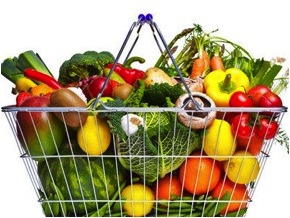
Shopping For Health
June 24, 2012 // Nutrition, Wellness
Information Overload.
The supermarket can be the hardest place to make a decision for the health-conscious consumer. Food manufacturers are constantly adjusting their marketing strategies to persuade the consumer to choose their product(s). A food item may appear to be healthier than its competitor solely because it highlights one of its nutrition benefits to distract from its complete nutritional profile. Consumers have become more aware of these strategies and are referring to health reports and publications for guidance. Unfortunately, there are a plethora of health sources that report different information and claims. Because of conflicting health claims, the excessive “awareness information” has caused hesitance, uncertainty, and health misconception in the general public. Let’s build up the consumer’s confidence and provide a mindset of health when food shopping.
What To Check.

Creating a mindset of health and compliance to an eating strategy changes the thought processes when choosing foods to purchase. The first and most important step in choosing a food product is to ask “How does this food affect my body?” Understand that foods are our sources for nutrients, vitamins, and minerals and can either help improve or negatively impact our current health. For example, if your goal is to stay lean, check the amount of carbohydrates in each food of your choice. Foods high in carbohydrates increase the waistline and are best for those desiring to gaining weight. Identifying the impact of each food is a great way to maintain compliance with specific eating strategies.
On the food label, take a look at the ingredients list. Even if you are not interested in recreating the foods with your culinary attempts, learning how to read the ingredients list can help you decide if the particular food is optimal for your health and fitness goals. The ingredients list is arranged by ingredient quantity within the food. The first ingredient listed makes up the largest portion of the food, while the last ingredient listed has been used the least. For example, Heinz Ketchup has the following ingredient list:
INGREDIENTS: TOMATO CONCENTRATE FROM RED RIPE TOMATOES, DISTILLED VINEGAR, HIGH FRUCTOSE CORN SYRUP, CORN SYRUP, SALT, SPICE, ONION POWDER, NATURAL FLAVORING.
Tomatoes and vinegar are listed as the first two ingredients, making them largest in quantity of substances in the Ketchup. However, high fructose corn syrup is third on the list. This ingredient when absorbed within the bloodstream can produce a dramatic increase in insulin, thus causing a rise in blood sugar level and fat storage. A simple condiment that is a summertime staple consumed by millions is a food carrying many negative health consequences. As you can now imagine, foods perceived as harmless can actually be the factors why cravings and shifts in hunger occur in many people. Reading only the food label alone would not normally identify this to a consumer, so that is why a consumer must analyze WHAT makes up their food(s).

Might as well be candy.
Real Health Insurance.
Most importantly, shopping for health is a strategy. Even the best intentions for improving health can be hindered by product availability and a poor mindset. It takes a great amount of willpower to stop someone from eating ready-to-eat “comfort foods” because they do not have the time to cook a healthy, fresh meal. For this problem, the best solution is to buy in bulk the foods you enjoy that also keep you compliant with your health goals. Plan for the worst and buy healthy food items that are instant, portable, and nutritious. Nuts are my personal favorite; a great source of healthy fats and a decent amount of protein. I have a mixed collection in my kitchen, locker at work, gym bag, and car. Figure out your routine habits and be creative in purchasing foods that act as “health insurance”, in case something goes wrong.
Let’s Review.
-
Walk into the grocery store and have a plan; skip the aisles of the temptations.
-
Find a food and ask yourself “How does this food affect my body?”
-
Look at the nutrition label.
-
Look even further at the ingredients list.
-
Buy in bulk.
-
Create “health insurance” foods and keep them readily available.
-
Stay ripped.